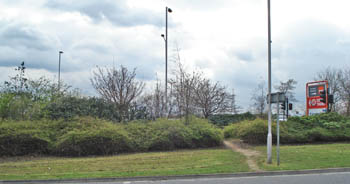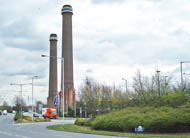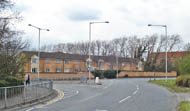Waddon Hospital
Waddon Marsh Lane, Purley Way, Croydon CR9 4PL
Medical dates:
Medical character:
Infectious diseases. Later, also TB and geriatric
In
1893 the Croydon Corporation decided to build an isolation hospital so
that patients with infectious diseases such as diphtheria and scarlet
fever should not have to be admitted to the Infirmary of the workhouse
or to the Croydon General Hospital.
Subsequently an 8-acre plot of land was purchased at Waddon, in
the western part of the Borough. Temporary hutted wards were built in
1894 for the isolation and treatment of infectious disease patients
while work began on the erection of the
permanent hospital.
The Croydon Borough Hospital for Infectious Diseases opened in 1886. It had 100 beds and had cost almost £25,000.
The Hospital consisted of pavilion blocks containing the wards. Each ward was divided internally into six compartments by longitudinal and transverse glazed partitions. The compartments each measured 12 ft by 12 ft (3.7 metres by 3.7 metres), with the ceiling 11 ft (3.4 metres) high. They were entered by separate doors from the outside verandah.
The Hospital was extended in 1911 to include two isolation pavilions and a Nurses' Home.
In 1930 an operating theatre was installed.
In 1948 the Hospital joined the NHS under the control of the Croydon and Warlingham Park Hospital Management Committee, part of the South West Metropolitan Regional Hospital Board. It was renamed the Waddon Hospital.
In 1954 only 179 of the 220 beds were open. Of these, 74 were in three wards for fever cases. 81 were for TB patients (including 37 patients accommodated temporarily from the Mayday Hospital which was undergoing ward renovation) and 24 for chronic patients with senile dementia (also from the Mayday Hospital). However, the beds remained at fever spacing, that is, 12 feet (3.7 metres) apart.
Although there was plenty of room for expansion, the Hospital was rather inaccessible. It was reached by a long private road from the Croydon Bypass (Purley Way), but there was no public transport along the Bypass, which made it difficult for visitors. The staff were transported to and from the Hospital and the centre of Croydon in a 30 cwt van.
By 1959 the Hospital had 189 beds, although the TB beds were rarely fully occupied since the Coombe Wood Convalescent Home had become a TB hospital in 1954.
In 1966 the Hospital had 188 beds for infectious diseases and geriatric patients.
In 1974, following a major reorganisation of the NHS, the Hospital came under the control of the Croydon Area Health Authority, part of the South West Thames Regional Health Authority. It had 106 beds for infectious disease, ophthalmic and geriatric patients. By 1976 it had ceased to deal with infectious disease patients.
The Hospital closed in 1984.
The Croydon Borough Hospital for Infectious Diseases opened in 1886. It had 100 beds and had cost almost £25,000.
The Hospital consisted of pavilion blocks containing the wards. Each ward was divided internally into six compartments by longitudinal and transverse glazed partitions. The compartments each measured 12 ft by 12 ft (3.7 metres by 3.7 metres), with the ceiling 11 ft (3.4 metres) high. They were entered by separate doors from the outside verandah.
The Hospital was extended in 1911 to include two isolation pavilions and a Nurses' Home.
In 1930 an operating theatre was installed.
In 1948 the Hospital joined the NHS under the control of the Croydon and Warlingham Park Hospital Management Committee, part of the South West Metropolitan Regional Hospital Board. It was renamed the Waddon Hospital.
In 1954 only 179 of the 220 beds were open. Of these, 74 were in three wards for fever cases. 81 were for TB patients (including 37 patients accommodated temporarily from the Mayday Hospital which was undergoing ward renovation) and 24 for chronic patients with senile dementia (also from the Mayday Hospital). However, the beds remained at fever spacing, that is, 12 feet (3.7 metres) apart.
Although there was plenty of room for expansion, the Hospital was rather inaccessible. It was reached by a long private road from the Croydon Bypass (Purley Way), but there was no public transport along the Bypass, which made it difficult for visitors. The staff were transported to and from the Hospital and the centre of Croydon in a 30 cwt van.
By 1959 the Hospital had 189 beds, although the TB beds were rarely fully occupied since the Coombe Wood Convalescent Home had become a TB hospital in 1954.
In 1966 the Hospital had 188 beds for infectious diseases and geriatric patients.
In 1974, following a major reorganisation of the NHS, the Hospital came under the control of the Croydon Area Health Authority, part of the South West Thames Regional Health Authority. It had 106 beds for infectious disease, ophthalmic and geriatric patients. By 1976 it had ceased to deal with infectious disease patients.
The Hospital closed in 1984.
Present status (March 2008)
Nothing remains of the Hospital and its site is now part of Valley Park, an out-of-town shopping centre containing, among others, an IKEA store.

Looking across Ampere Way towards Valley Park - a combination of the sites of the Croydon 'B' power station, the Hospital and part of the Beddington sewage farm.


The IKEA store was built on the site of the power station but its chimneys have survived (left). New housing has been built on the north of the combined sites.
(Author unstated) 1895 Croydon Borough Hospital. British Medical Journal 2, (1808), 508.
Parsons HF 1922 Isolation Hospitals, 2nd edn. Cambridge University Press.
http://uk-genealogy.org.uk
www.addiscombe.net
www.british-history.ac.uk
www.croydonhealthservices.nhs.uk
www.francisfrith.com
www.pastscape.org.uk
Return to home page